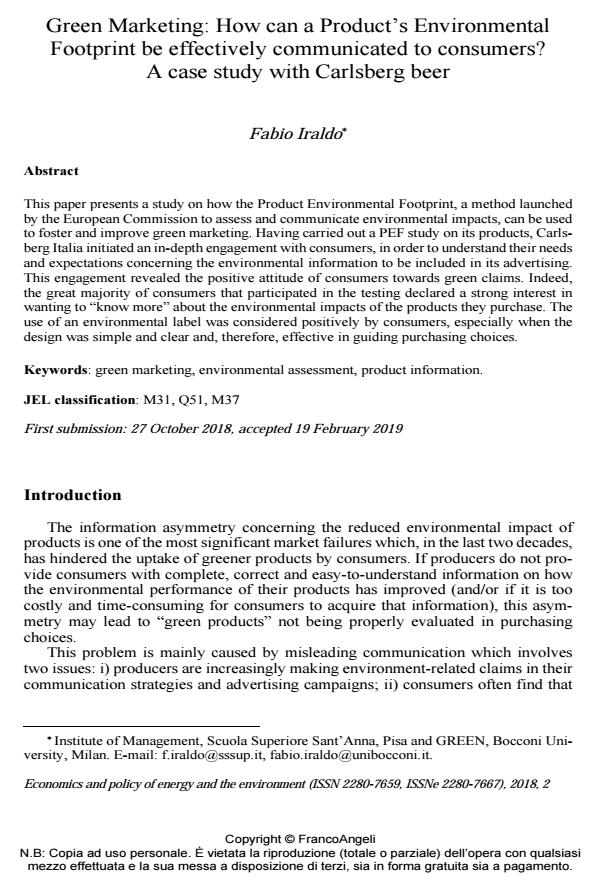Green Marketing: How can a Product’s Environmental Footprint be effectively communicated to consumers? A case study with Carlsberg beer
Journal title ECONOMICS AND POLICY OF ENERGY AND THE ENVIRONMENT
Author/s Fabio Iraldo
Publishing Year 2019 Issue 2018/2 Language English
Pages 20 P. 167-186 File size 427 KB
DOI 10.3280/EFE2018-002009
DOI is like a bar code for intellectual property: to have more infomation
click here
Below, you can see the article first page
If you want to buy this article in PDF format, you can do it, following the instructions to buy download credits

FrancoAngeli is member of Publishers International Linking Association, Inc (PILA), a not-for-profit association which run the CrossRef service enabling links to and from online scholarly content.
This paper presents a study on how the Product Environmental Footprint, a method launched by the European Commission to assess and communicate environmental impacts, can be used to foster and improve green marketing. Having carried out a PEF study on its products, Carlsberg Italia initiated an in-depth engagement with consumers, in order to understand their needs and expectations concerning the environmental information to be included in its advertising. This engagement revealed the positive attitude of consumers towards green claims. Indeed, the great majority of consumers that participated in the testing declared a strong interest in wanting to "know more" about the environmental impacts of the products they purchase. The use of an environmental label was considered positively by consumers, especially when the design was simple and clear and, therefore, effective in guiding purchasing choices.
Keywords: Green marketing, environmental assessment, product information.
Jel codes: M31, Q51, M37
- Banerjee, A., Solomon, B. D. (2003). Eco-labeling for energy efficiency and sustainability: a meta-evaluation of the US programs. Energy Policy, 31(2): 109-123.
- Banerjee, S., Gulas, C.S, Iyer, S. (1995). Shades of Green: A Multidimensional Analysis of Environmental Advertising. Journal of Advertising, 24(2): 21-31. DOI: 10.1080/00913367.1995.10673473
- Carlson, L., Stephen, J. G., Kangun, A.N. (1993). Content Analysis of Environmental Advertising Claims: A Matrix Method Approach. Journal of Advertising, 22(3): 27-39. DOI: 10.1080/00913367.1993.10673409
- Chan, R. Y. K. (2004) Consumer responses to environmental advertising in China. Marketing Intelligence and Planning, 22(4): 427-437. DOI: 10.1108/02634500410542789
- Chan, R. Y. K. (2001) Determinants of Chinese consumers’ green purchase behavior. Psychology and Marketing, 18(4): 389-413.
- Chang, H. J., Watchravesringkan, K. (2018). Who are sustainably minded apparel shoppers? An investigation to the influencing factors of sustainable apparel consumption. International Journal of Retail and Distribution Management, 46(2): 148-162. DOI: 10.1108/ijrdm-10-2016-0176.
- Chekima, B. C., Syed Khalid Wafa, S. A. W., Igau, O. A., Chekima, S., Sondoh, S. L. (2016). Examining green consumerism motivational drivers: Does premium price and demographics matter to green purchasing? Journal of Cleaner Production, 112: 3436-3450.
- Easterling D., Kenworthy A., Nemzoff R., College B. (1996). The Greening of adevertising: a twenty five year look at environmental adverstising. Journal of Marketing Theory and Practice, 4(1): 20-34. DOI: 10.1080/10696679.1996.11501714
- Eurobarometer (2014). Attitudes of European citizens towards the environment. Special Eurobarometer 416.
- Goh, S.K., Balaji, M.S. (2016). Linking green skepticism to green purchase behavior. Journal of Cleaner Production, 131: 629-638.
- Iraldo, F., Melis, M. (2012) Green Marketing, Milano: Il Sole 24 Ore Editore.
- Kangun, N., Carlson, L., Grove, S. J. (1991). Environmental advertising claims: a preliminary examination. Journal of Public Policy and Marketing, 10(2): 47-58. DOI: 10.1177/074391569101000203
- Karna, J., Hansen, E. Juslin, H. (2003). Environmental activity and forest certification in marketing of forest products – a case study in Europe. Silva Fennica, 37(2).
- Karna, J., Juslin, H., Ahonen, V., Hansen, E. N. (2001). Green advertising: greenwash or a true reflection of marketing strategies? Greener Management International, 33.
- Khare, A., Sadachar, A. (2017). Green apparel buying behaviour: A study on Indian youth. International Journal of Consumer Studies, 41(5): 558-569.
- Leonidou, L.C., Leonidou, C.N., Palihawadana, D., Hultman, M. (2011). Evaluating the green advertising practices of international firms: a trend analysis. International Marketing Review, 28(1): 6-33. DOI: 10.1108/02651331111107080
- Robinot, É., Ertz, M., Durif, F. (2017). Jingle bells or ‘green’ bells? The impact of socially responsible consumption principles upon consumer behaviour at Christmas time. International Journal of Consumer Studies, 41(6): 605-617.
- Seung Bong Ko, Byoungho Jin (2017). Predictors of purchase intention toward green apparel products: A cross-cultural investigation in the USA and China. Journal of Fashion Marketing and Management: An International Journal, 21(1): 70-87.
- Testa, F., Iraldo, F., Tessitore, S., Frey, M. (2011). Strategies and approaches green advertising: an empirical analysis of the Italian context. International Journal of Environment and Sustainable Development, 10(4): 375.
- Testa, F., Iraldo, F., Vaccari, A., Ferrari, E. (2013). Why Eco‐labels can be Effective Marketing Tools: Evidence from a Study on Italian Consumers. Business Strategy and the Environment, 24(4): 252-265
- Wessells, C., Johnston, R., Donath, H. (1999). Assessing consumer preferences for ecolabelled seafood: the influence of species, certified and household attributes. American Journal of Agricultural Economics, 81(5): 1084 DOI: 10.2307/1244088
- Challenges with product environmental footprint: a systematic review Emil Pedersen, Arne Remmen, in The International Journal of Life Cycle Assessment /2022 pp.342
DOI: 10.1007/s11367-022-02022-3
Fabio Iraldo, Green Marketing: How can a Product’s Environmental Footprint be effectively communicated to consumers? A case study with Carlsberg beer in "ECONOMICS AND POLICY OF ENERGY AND THE ENVIRONMENT" 2/2018, pp 167-186, DOI: 10.3280/EFE2018-002009